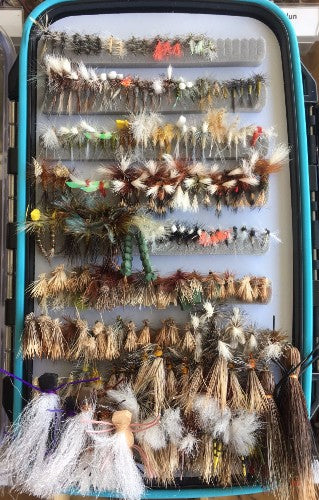
The 5 Steps to Choosing the Best Fly Pattern
(This article is a follow up to a previous article titled “Take a Moment and PAUSE” published first in July of 2016 and describing the 5 places around and in the river to identify what foods trout are most likely eating. If you haven’t read that article, take a moment to do so on our blog by CLICKING HERE before continuing.)
As anglers, our role is one of both detective and hunter. In order to improve the odds of choosing the best fly patterns and hooking more fish, we need to become students of the river. As we hike along the river bank and draw up rocks from its bubbling depths, every spiderweb laden with bugs, the flight pattern of insects startled from streamside willows, and the number of tails on a nameless nymph offer us valuable clues as to what the trout are likely feeding on. Each of these observations is a puzzle piece that should be assembled within the pages of our fly box and inform our choice of fly patterns to give us the best chance of hooking up. So when you are ready to put your seine samples and observation to work, here are five easy points to consider as you MATCH the hatch.
Most Abundant
It is a logical conclusion that the insect families and life cycles that we observe the most of on and in the water are also those that the trout have the greatest opportunity to feed upon. We will therefore give priority in our fly selection to the insects that are Most Abundant. Did you observe 20 caddisflies skipping over the surface of a river pool and only a solitary mayfly? We will most likely experience more success with an Elk Hair Caddis instead of a dry mayfly pattern.
Approximate Size & Profile
After years of working as an Aquatic Biologist and a lifetime as an angler, I am fully convinced that trout do not know the names of the flies in our fly boxes. They don’t care that we call a pattern a parachute caddis, and will be just as happy to eat said “caddis pattern” when it is fished during an early brown stonefly hatch so long as it is the Approximate Size & Profile of the majority of the insects sampled in or on the water. “Close enough” fished well is usually good enough to get the job done!
Trout Feeding Behavior
Trout will follow and focus on the greatest concentration of food in the water column. They may start the day feeding on mayfly nymphs along the bottom of the river, chase those nymphs towards the surface as they begin their hatch, and then focus their attention on the fully emerged duns and spinners as they drift across the surface of the water. This migration most likely will occur many times each day, and we will allow the Trout Feeding Behavior to inform our fly selection and which insect life cycles we choose to fish.
Color
Get close in Color to the natural insects when choosing a fly pattern and then add a little flash. Even a slight contrast created by the addition of a metal beadhead, a bright wire wrap, or flashback will help you seduce the attention and aggression of the trout.
Half an Hour
Matching the hatch and what trout are feeding on throughout the day is a moving target. There is going to be some trial and error to the process, so don’t be afraid to change out your flies if you are not getting strikes. If the action has been dry for Half an Hour, it’s time to change up your flies.




